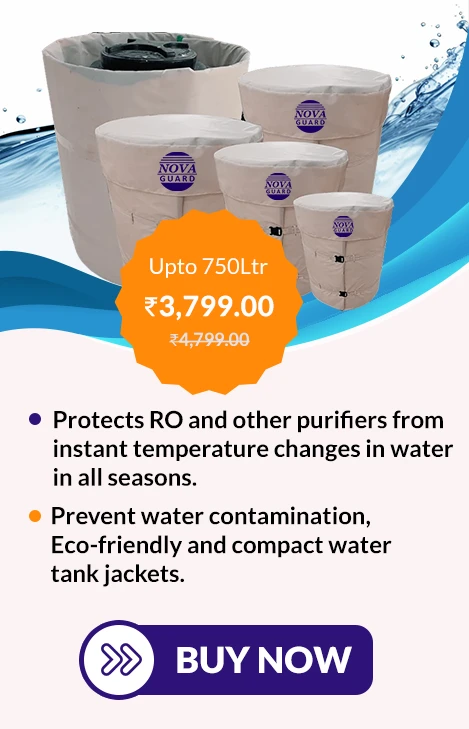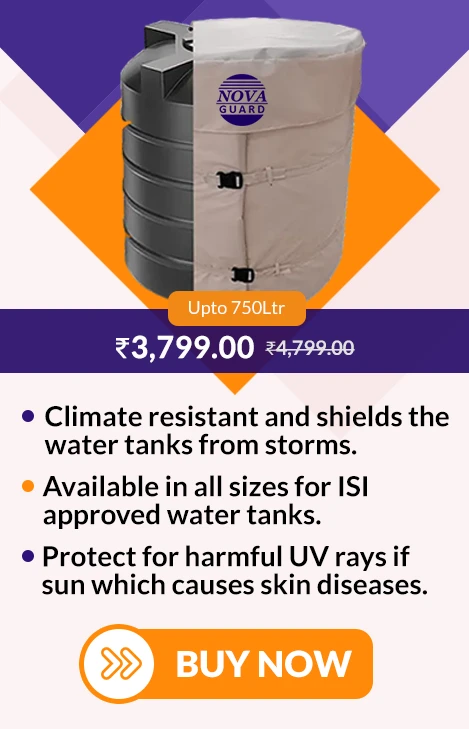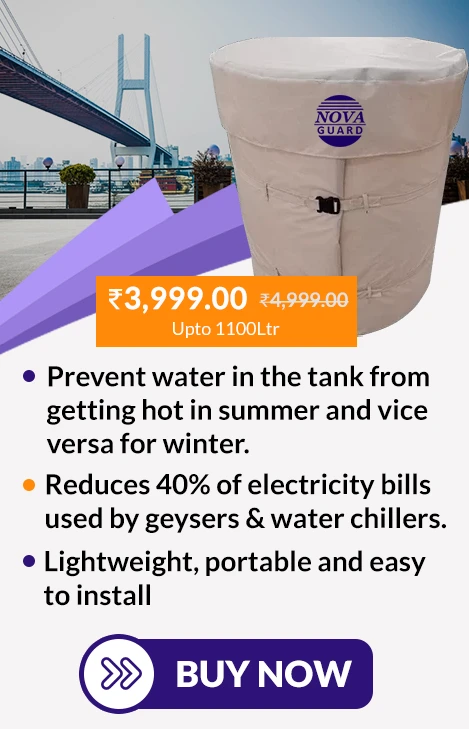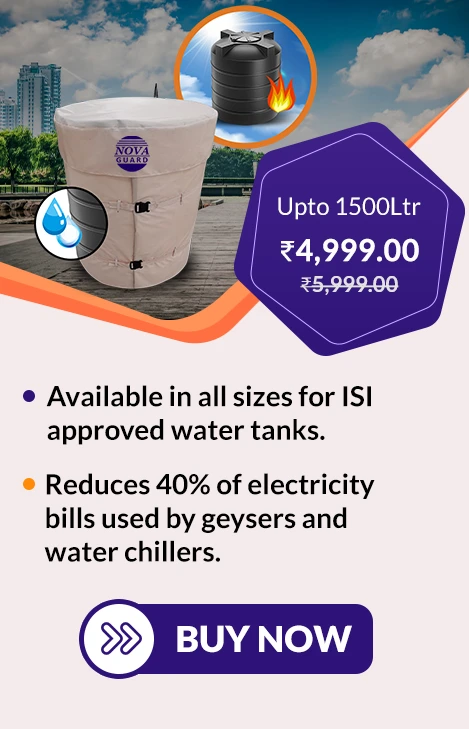
Publish on: Jul 15, 2024 Updated on: Jul 16, 2024
How to Insulate Your Water Tank: A Step-by-Step Guide
There is no need to tell the importance of storing water and its usage in homes. Whether it is showering, washing clothes, doing laundry, or any other purpose, water is a must have thing. However, people face issues during winter when they suffer from high electricity utilization to keep the water warmer.
This is where insulation comes in as a one stop solution to prevent heat loss from the tank in winter, reduce electricity consumption, and make hot water easily available whenever needed.
Nowadays, water tank insulation is not an option anymore. It is becoming a crucial step to protect the water tank in homes. Property insulated water tank can keep your stored water warmer in the winter and keep it pure.
However, water tank insulation is quite a difficult task and proper insulation is necessary to get all the associated benefits. There are various do it yourself type water tank covers and jackets available for different types of water tank, you just need to properly cover the water tank with the installation kit.
So, if you are doing water tank insulation first, then this guide will help you. Here, we will deep dive into water tank insulation, its types, materials and step by step process to properly insulate your water tank.
How to Insulate Your Water Tank?
Insulating your water tank with a cover is a practical procedure. Follow the given steps below:
Step 1. Turn Off Water Supply and Heater
Before starting the insulation, you should turn off the water supply to the tank and the heater. It will ensure safety and prevent water leaking while insulating the water tank.
Step 2. Measure and Clean the Tank
Now, use a measuring tape to measure the height and width of your water tank. It will help you to buy the right size and shape of insulation cover that can fit well. Once the measuring is done, then clean the water tank surface and dirt, so that insulation sticks better.
Step 3. Gather Necessary Materials
It is time to gather the necessary materials required for proper water tank insulation, including:
Insulation cover or jacket with the kit (at least R-8 value)
- Duct tape
- scissors
- Cloth or cleaning rag
- Marker
- Measuring tape
- Gloves and dust mask
Once you gather all these materials, then, you are now ready for proper water tank insulation.
Step 4. Cut the Insulation Jacket to Size
Now, based on the measurement you took earlier, take a marker and mark the area to cut the insulation cover. But make sure you are leaving the space for controls, pipes, and the top of the water tank.
Don’t worry if you do not have an accurate measurement because you can cut the excess part after the insulation fitting.
Step 5. Wrap and Secure the Insulation Around the Tank
Start wrapping the insulation cover around the water tank. You can start from the bottom and go up by considering all the holes, controls, and pipes. Use insulation or duct tape to place it properly and make sure there are no loose areas.
Also take a marker to mark the areas around controls, pipes and holes that you can cut out later after the complete wrap up.
Step 6. Check for Gaps and Ensure Proper Sealing
Once you have wrapped the insulated cover on your water tank, then check for any gaps or loose areas.
Find the marked areas where the controls are and cut them out. Then, use duct tape to seal tight if there are any gaps left.
Step 7. Turn the Water Supply and Heater Back On and Inspect Carefully
Now that you have properly insulated the water tank with cover it is time to turn on the water supply and the heater so that you can check the water tank carefully to see if there are any leaks or whether the insulation is properly covered.
That’s it! These are the simple steps to take to properly insulate your water rank.
Types of Water Tank Insulation
There are different types of water tank insulation available as per different needs. You can choose which type of insulation is suitable for your water tank:
1. Insulation Jackets
Thermal Water Tank Insulation jackets are preformed insulated covers that are made up from different materials. SUch as fiberglass, polyurethane foam, aerogel or wool. These are very common types of insulation covers which can easily wrap the water tanks, prevent heat loss in cold weather and reduce energy consumption. It is an ideal insulation for both residential and commercial water tanks.
2. Polystyrene Foam Boards
Polystyrene Foam Boards are lightweight, rigid and easy to cut & fit around water tanks. It is a cost effective solution and easily fit for different sizes and shapes of water tanks. Polystyrene foam is moisture resistant and has high R-value which means good insulation properties that reduce heat loss and maintain the water temperature. It is commonly used in both new installations and retrofitting installations.
3. Spray Foam Insulation
Spray foam insulation is especially used for those water tanks which are irregular shaped and unable to cover with sheet or something. This foam layer can be directly applied to the water tank surface and make sure no gaps are left. This type of insulation is used when there is a high need of keeping the temperature warmer in cold weather.
4. Mineral Wool Insulation
There are some residential and commercial buildings where water tanks are placed just below the sunlight, where the weather directly impacts the water tank temperature. Mineral wool insulation has high temperature and acoustic properties that help to resist fire and maintain temperature.
5. Reflective Bubble Insulation
Reflective bubble insulation is another type of water tank insulation, typically aluminum foil. This helps to reduce the heat transfer and focuses on maintaining the water tank temperature.
Water Tank Insulation Materials
Here are some of the most common insulation materials used in different water tank insulation:
1. Polyurethane Foam (PUF)
The polyurethane foam material is used in spray foam insulation, where a liquid foam is applied on water tanks that later expand and become a hard insulating layer. This type of insulation is used for irregular shaped water tanks to keep the tank moisture protected.
2. Fiberglass
Fiberglass material is used in insulated covers and jackets, which can be easily wrapped around any shape and size of water tanks. This type of insulation is fire resistant and easy to install or remove and maintain the water temperature effectively.
3. Reflective Foil
Reflective foil material is used in reflective insulation where layers of aluminum foil are used to cover the water tank and reflect heat away. It is especially used for outdoor water tanks to protect from direct sunlight.
4. Mineral Wool
Mineral wool (also known as Rockwool) is a thermal, fire resistant, acoustic material made from recycled materials. It is used in batt and blanket insulation to help prevent heat loss, reduce energy, and provide high durability.
5. Aerogel
Aerogel is thermal resistance and ultra lightweight insulation material which is used in blankets or panels insulation. These are best fit for both residential and commercial water tanks where maintaining water temperature is critical. It can be easily cut and fit as per the water tank shape and size to prevent heat loss and reduce overall energy costs.
6. Elastomeric Foam
Elastomeric Foam is one of the most flexible, durable and high efficient insulation materials which is used in wraps and sheets insulation. This material has a closed cell structure which makes it particularly used for insulating cold water tanks, pipes and ducts for moisture control.
Choosing the Right Insulation for a Water Tank
Here are five things to consider when choosing the right insulation for a water tank:
1. Thermal Performance (R-Value)
When you are looking for the right insulation then make sure that thermal performance (R-value) must be higher. Because thermal performance high means the material will maintain the water tank temperature more effectively. It will keep water hot in winter and cool in summer. So, you should always look for high R-value materials based insulation.
2. Compatibility with Tank Material
You can not use any type of insulation material for your water tank; there are different types of insulation materials available. You should identify which type of water tank you have and then look for insulation material which is compatible with your water tank. Because choosing a compatible material can help long lasting durability, reduce heat prevention and energy efficiency.
3. Ease of Installation
Different insulation materials have different installation procedures. So, it is important for you to choose the insulation that has an easy installation process. Fiberglass batts or jackets can be easily installed by wrapping up the water tank and using tape to seal it. On the other hand, spray foams require professional help to do the insulation properly. So, make sure to choose insulation that is easy to install as per your water tank.
4. Durability and Longevity
When you are planning for water tank insulation, then, surely you want high quality insulation that has a long lifespan, especially if your water tank is directly below the sun’s rays, which can affect the durability of the water tank. At this point, you should consider insulation, which can prevent heat loss and enhance the durability of the water tank.
5. Cost
Budget matters the most and you should consider insulation which comes under your budget, has high R-value and longevity.
Conclusion
In order to protect your water tank from heat and high electricity bills and shorten its lifespan, water tank insulation is essential. It will help protect your water tank from direct sun rays, prevent heat loss, reduce electricity bills, and increase its longevity. However, it is only possible when you do proper insulation of your water tank with the right material type. That’s why we have covered everything about water tank insulation, its types, materials, and factors so that you can choose the right insulation for your water tank and follow the given steps to do insulation property. We hope this guide helps you know everything, and now you are ready to switch to a better option for energy efficiency and durability and get an easy supply of hot water in winter and cool water in summer..
FAQs – How to Insulate Your Water Tank<
Q.1 What is the best insulation for a water tank?
The best insulation for a water tank depends on various factors. However, the most common and best insulation is insulation jackets or covers, which can be used to protect the different shapes and sizes of water tanks in residential and commercial buildings. This insulation can be easily installed or removed to efficiently maintain water temperature and reduce electricity consumption.
Q.2 What is the best material for insulating a water tank?
Polyurethane foam, aerogel, fiberglass, and wool are considered some of the best insulation materials for a water tank because these materials contain high R-value and durability.
Q.3 How to make a water tank heatproof?
By doing proper water insulation, you can make your water tank heat proof. This insulation will create a layer around the water tank, which prevents heat loss during summer and keeps the water cool in summer.
Q.4 How do I maintain the insulation on my water tank?
Regular inspection can help to maintain the insulation of your water tank. If you see any sign of damage, crack, or gaps around the insulating layer, then you should fix or replace the insulation immediately.






